
The late 90s and early 2000s were a special time for personal computers. The cost of PCs dropped significantly, we switched from dial-up to broadband internet, and we struggled with Windows ME waiting for XP to arrive. Some of us then went the homemade road, while others started buying ready-made assemblies of desktop computers in stores.
One of the notable entrants in the race to the bottom at the time was eMachines , founded in 1998. Later it was bought by Gateway, which in turn was bought by Acer. Many systems from eMachines were then sold to users on a small budget with the "Never Obsolete" sticker. These devices introduced a whole generation to ATI Rage graphics cards.II and Rage Pro. The first system I tried to run games on had Rage LT Pro AGP integrated graphics. I spent many hours playing Unreal Tournament then (and before that I was a console player, and spent countless hours on Gran Turismo).
Last year I went looking for a retro PC, and I ended up in a kind of rabbit hole. I started with a Compaq Presario 5050 in a mini-tower case, which outwardly resembled the PC from which I started my DIY journey. Then I searched the forums dedicated to the computer hardware, modified drivers (to be exact, Rage3D). Eventually, I met my best friend, and it kick-started my career in the tech industry. However, one Compaq PC wasn't enough for me, and I regularly scoured OfferUp, Facebook Marketplace, and Craigslist for old systems.

eMachines: Never Obsolete
While looking for old computer nishtyak I came across an ad for the sale of eMachines T1090. It wasn't the beige 'Never Obsolete' decal that eMachines became famous for - it was a second-generation case that was rounder and sleeker. The computer came out in 2001, it was running Windows XP, and it boasted a Celeron 900 MHz, 128 MB SDRAM and an Intel i810 chipset - a rather weak configuration that was already outdated at the time of its release. However, in the segment in which eMachines competed with other manufacturers, price was the main factor. It could be bought for $ 474.99, and then mailed a $ 75 compensation coupon, which cost the system $ 399.99 - not much. Adjusted for inflation, it would cost $ 585 today, and for that money you can buy a good budget computer.
I didn't need the computer hardware, but I really wanted to put together a sleeper [the term sleeper as applied to cars means a car with a powerful filling and an unremarkable appearance / approx. transl.]. I was inspired by the work of the guys from the BSMOds project with a magnificent rework of the Juniper Networks case (retro mod). People who know me will confirm that I am too obsessed with all sorts of small details that ordinary people will not notice, so my sleeper had to be different from others.

EMachines T1090 Case
Rage Against The eMachine
I paid $ 40 for the computer, brought it home, and immediately began to take it apart to bare metal. The ventilation in the eMachines case was so-so, so I took out my Dremel, cut out a 120mm fan hole in the front, a hole in the bottom, and added a 70mm fan on top. For the computer, I took a b / n from a Corsair SF750 SFX - it is less than the stock b / n by 150 watts, and produces five times more power.
Like most modern b / cs, the Corsair SF750 is painted black and would not match the gray interior of eMachines. This did not suit me, so I disassembled it, processed some parts with sandblasting, and others with sandpaper by hand.
The rounded design required a dedicated optical drive panel. I could have just settled on a stock Samsung IDE CD-RW, but that wouldn't be interesting at all. I scoured eBay for a specific Samsung Blu-ray drive, discontinued five years ago, that seemed to have similar panel attachment points, and I was lucky. The panel from eMachines fits perfectly with the Samsung SATA Blu-ray drive. But I had to cheat with the floppy disk drive. Initially, I planned to use the LS120 with an IDE to USB adapter, but due to problems with the orientation of some connectors on the motherboard, this plan was covered. As a result, I glued the USB-C port with transparent glue into the slot from the drive.

The stuffing plans were related to the AMD Ryzen processor and Radeon graphics, as the AMD K6-2 / III and ATI Rage LT Pro, modern to this computer, have a special place in my heart. Since this was a standard mATX case, I figured a standard motherboard would fit into it without any problems. I was very wrong. Due to the small size of the case on most motherboards, the RAM slots rested against the cage for the floppy drive - I had to undermine it anyway.
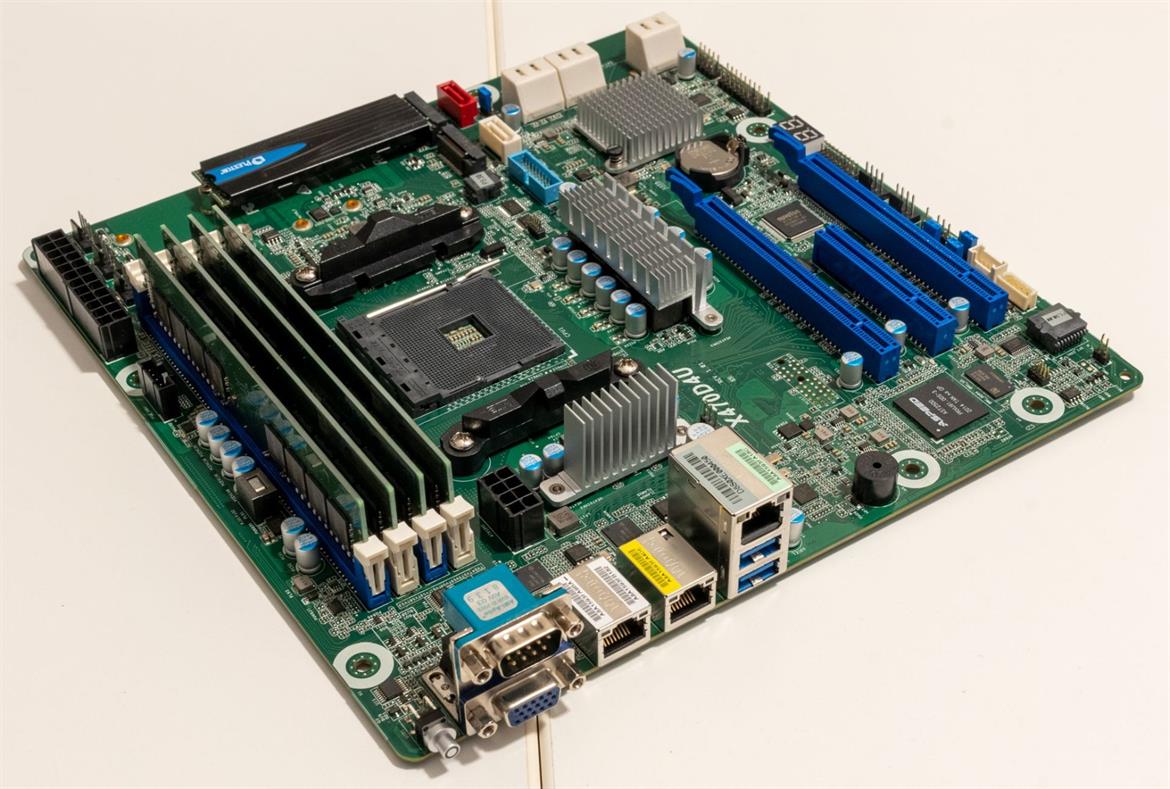
For hours I rummaged through the specifications of the motherboard manufacturers, looking for the right one. I exchanged opinions with a friend at AMD, and he planted an idea in my head that eventually sent me down a different rabbit hole: find a green motherboard that matched the color of the PCBs of that era. I got fired up with this idea and began to study modern green components, eventually settling on a key set. Coincidentally, ASRock, which manufactures hardware for servers and workstations, is selling a green mATX X470 board - X470D4U. They promised to release a new motherboard based on X570 this year, but I didn't want to wait. The downside to using a server board is its spartan nature. It has only two USB 3.0 ports, one USB 3.0 connector and no sound.

I solved the problem with the lack of USB 3.0 ports using an internal USB 3.0 hub from Sabrent, which coincidentally also had a green card, and expansion brackets with USB 3.0 ports. The adapter has three internal USB 3.0 connectors and two USB 2.0 ports. It also has a SATA power connector, but it broke. Unfortunately, the new internal hubs from Sabrent are no longer available for sale.
I chose my AMD Ryzen 7 3800X processorwith a custom heatsink set at 65W, a Noctua NH-L9a-AM4 low profile fan and Thermal Grizzly Kryonaut. Kingston's ValueRAM is still available on green boards, perfect for assembly. The original system had 128 MB of memory, so it was logical to add memory there to a maximum of 128 GB. Finding an SSD with a green board was difficult. Fortunately, Plextor, formerly known for its CD burners and now owned by Lite-On, makes a whole line of green-board SSDs. A 1TB M8Se NVME SSD went into the assembly.
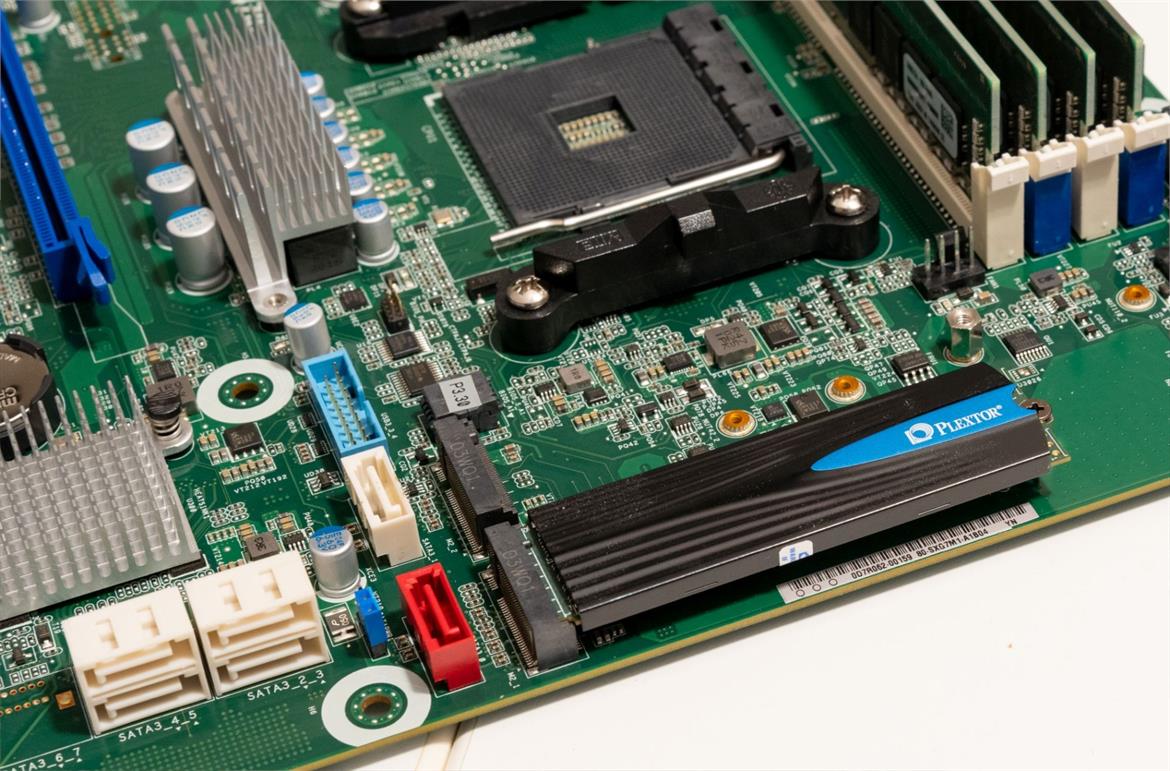
I chose my AMD Radeon RX 5700 XT graphics card- for its 7nm Navi architecture and radiator appearance. I did not find a modern card with a green card, but in those days, graphic cards were made in different colors - orange, blue, red and black. I chose a card with an air-guiding shroud that blows it straight out to the back as I didn’t expect good ventilation from the eMachines case.
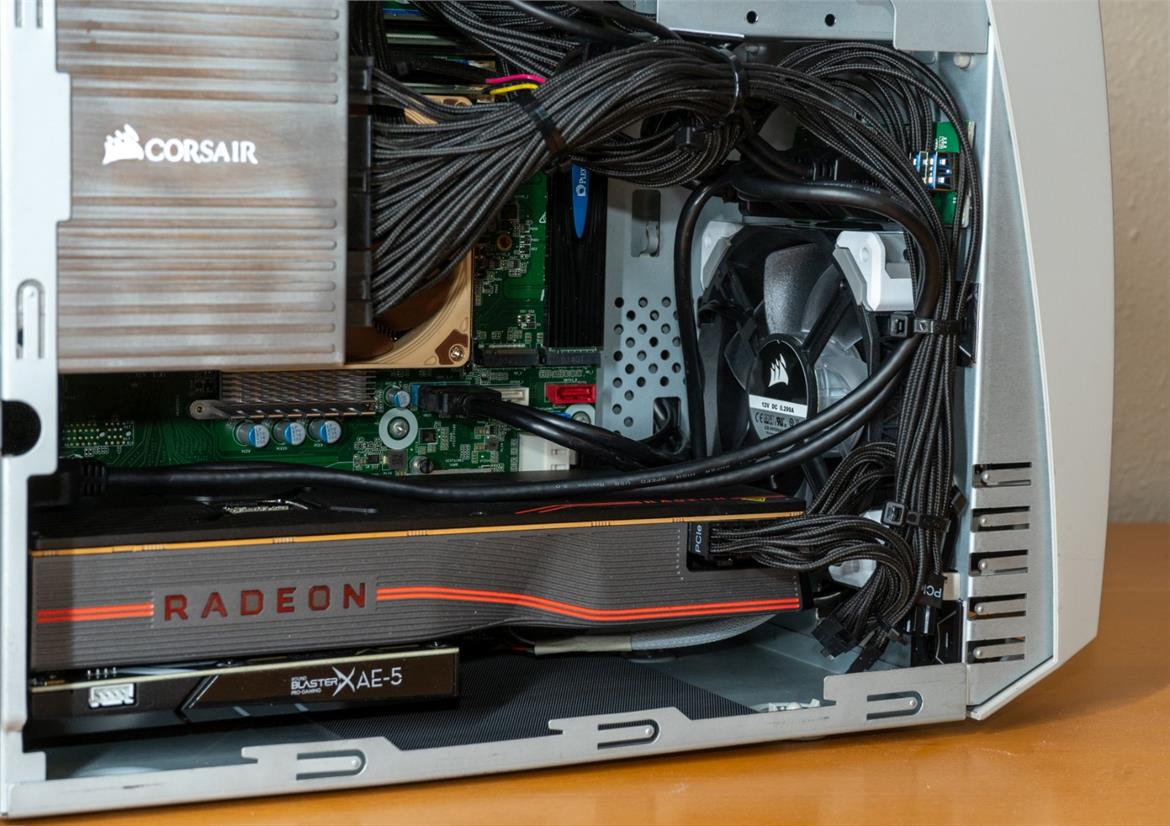
One of the pillars of that time was Creative Labs Sound Blaster Live sound cards, so there was no question of choosing a card for this assembly. I was impressed with the results that the Sound BlasterX AE-5 card showed in my review, and it was still on my shelf, so it went into assembly. The downside is that the Sound Blaster AE-5 board is not green - but the Sound Blaster Live also did not have a green board, so the spirit of the times is not broken.
AMD-powered eMachines T1090 retromode: the finishing touches
It wasn't enough for me to cram modern hardware into an old case, I needed to modify the picture with retro logos and stickers corresponding to the assembly. I once really wanted to get an AMD K6-III processor, and I used its logo as a starting point for my retro Ryzen sticker. I easily found the high quality K6-III vector logos, so making the sticker was not difficult.
Finding the high quality ATI Rage II / Pro / 128 logo was more difficult. Luckily, I was able to get in touch with Eric Poner, the former Creative Director of AMD at the time. He informed me that they used the Matrix II ExtraBold font for the logo and converted it to italics. Armed with this information, I recreated the logo in the same retro style.

I didn't stop there. When I bought the computer, the original spec sticker was still on it, but the glue was already very bad. So I scanned it, exactly recreated the style and font, only with the updated specifications. Of course, without the "Never Obsolete" sticker, it won't be eMachines, so I made it too, then glued it to the Blu-ray drive.

Printing labels turned out to be more difficult than designing them. I ordered the white labels to be printed on an old Oki color laser printer, not calibrated for good color reproduction. After a dozen changes in attempts to find the color closest to the original, I spat and settled on a fairly good option. Initially, I planned to print the stickers and cut them the old fashioned way - with scissors. Luckily, my amazing and artistic wife is supportive of my crazy endeavors and she used her Silhouette Cameo cutter to precisely cut decals, rounded corners and all.

The system would not be complete without the appropriate control panel
Equipping AMD-based retro fashion with peripherals
I really wanted to find an old LCD monitor from eMachines and put a modern display in it, but this task was beyond my capabilities. I settled on the budget 27 "LG 27MN60T because of its silver stand, which matches eMachines gray much better than a black or white monitor. It's a regular 1080p 75Hz IPS panel that supports AMD FreeSync - nothing fancy, but it works it does its job, while being attractive in appearance.
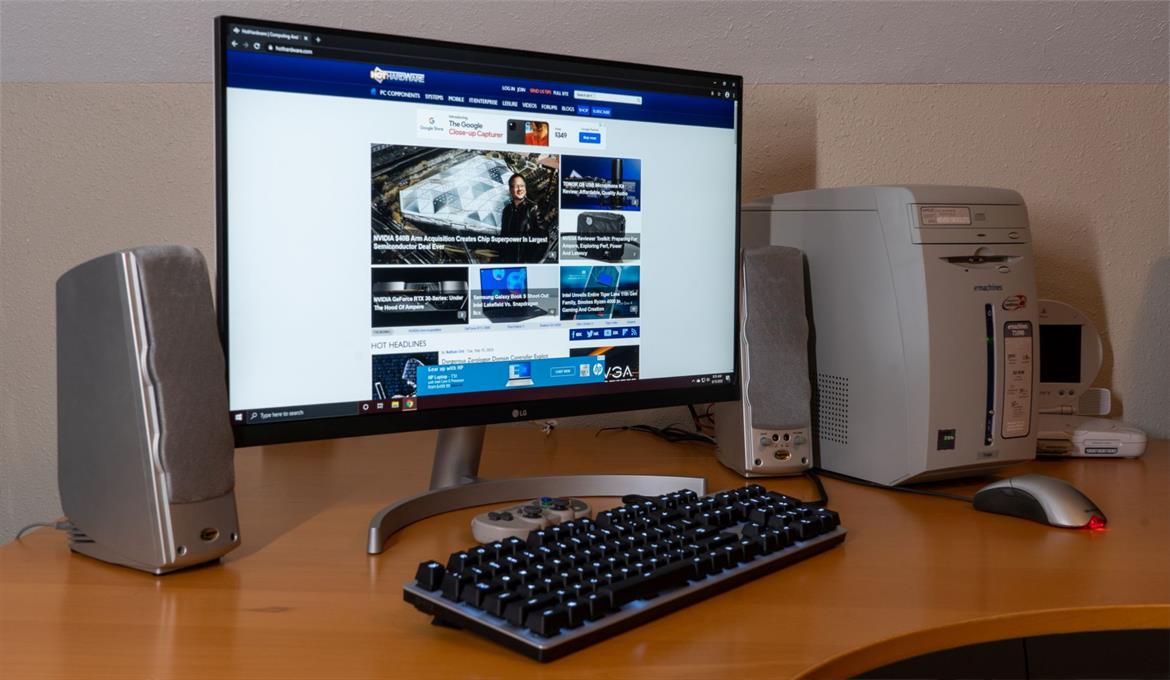
The choice of speakers suitable from an aesthetic point of view was limited. I wanted to find a Klipsch ProMedia 2.1as they were some of the best speakers when the original computer came out. However, I wanted to keep the silvery gray appearance and didn't want to give the subwoofer any extra space. Fortunately, a pair of undersized Klipsch ProMedia 2.0 Ultra for $ 20 appeared on the Facebook flea market - it was perfect. ProMedia 2.0 Ultra came out in 2004, but it was close enough for me.
All that remained was the keyboard and mouse. I usually use peripherals from Logitech and chose the G413 Silver for color matching. I took an old mouse - I had an extra Microsoft IntelliMouse Explorer 3.0, which fit perfectly into the kit. Last year Microsoft released an updated version of Pro Intellimouse, with a design in the old Explorer style, but with a new PixArt sensor with increased DPI. I ordered one for myself, but she did not have time to come to me before the photo session. The 8BitDo SN30 Pro controller completes the big picture - you can't play Fall Guys with a keyboard and mouse.
Performance tests and final impressions
This mod cannot be considered complete without a couple of performance tests - just to show off the system's capabilities. To do this, I used several familiar programs from our set - ATTO Disk Benchmark, Speedometer 2.0, PCMark 10, Cinebench R20, 3DMark Time Spy and Shadow of the Tomb Raider. Since we usually describe the most advanced desktop computers in our reviews, this mod from eMachines is unlikely to perform well against their background. Consider that it originally featured a 900MHz Celeron, 128MB of RAM, AC'97 audio, and an incredible Intel i810E graphics chip.
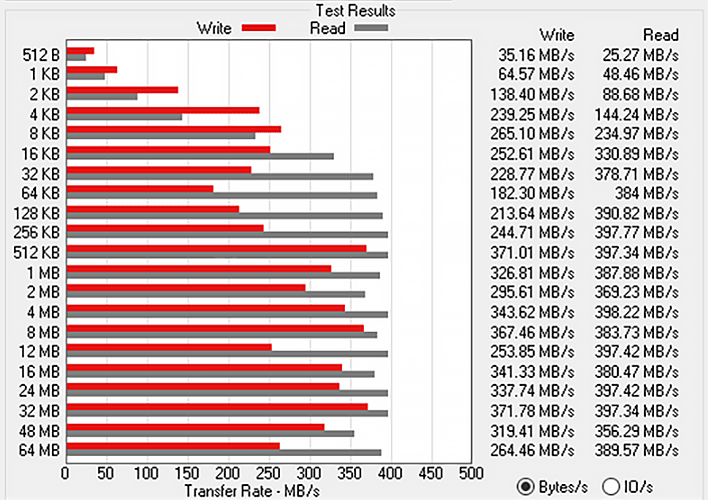

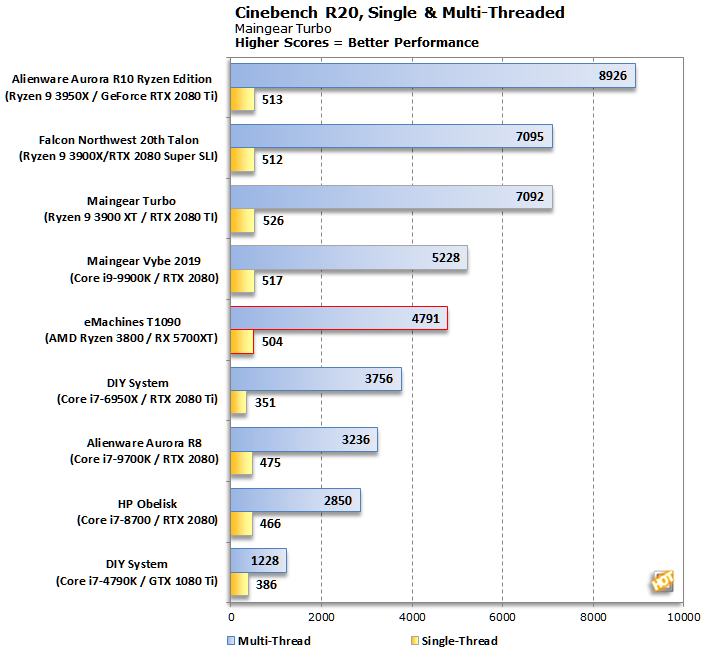
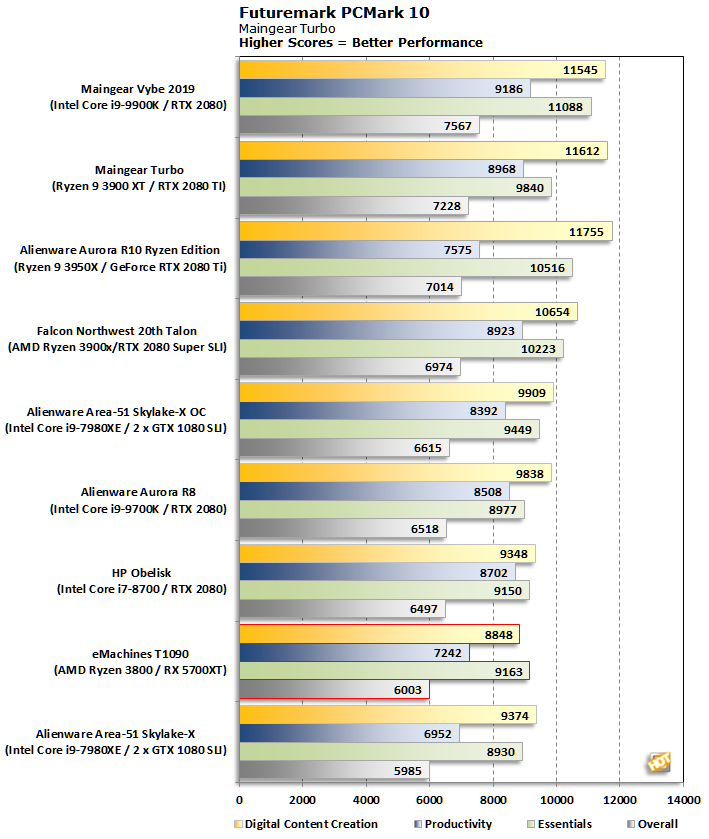
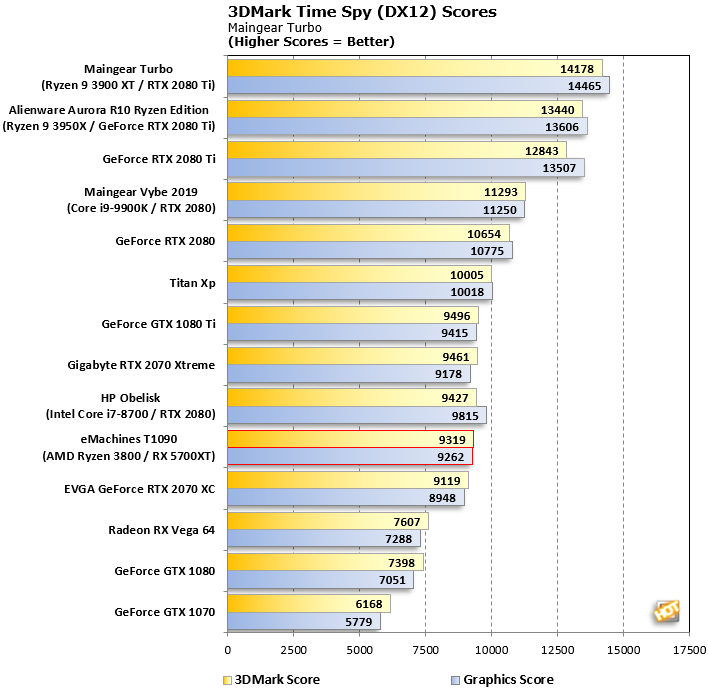
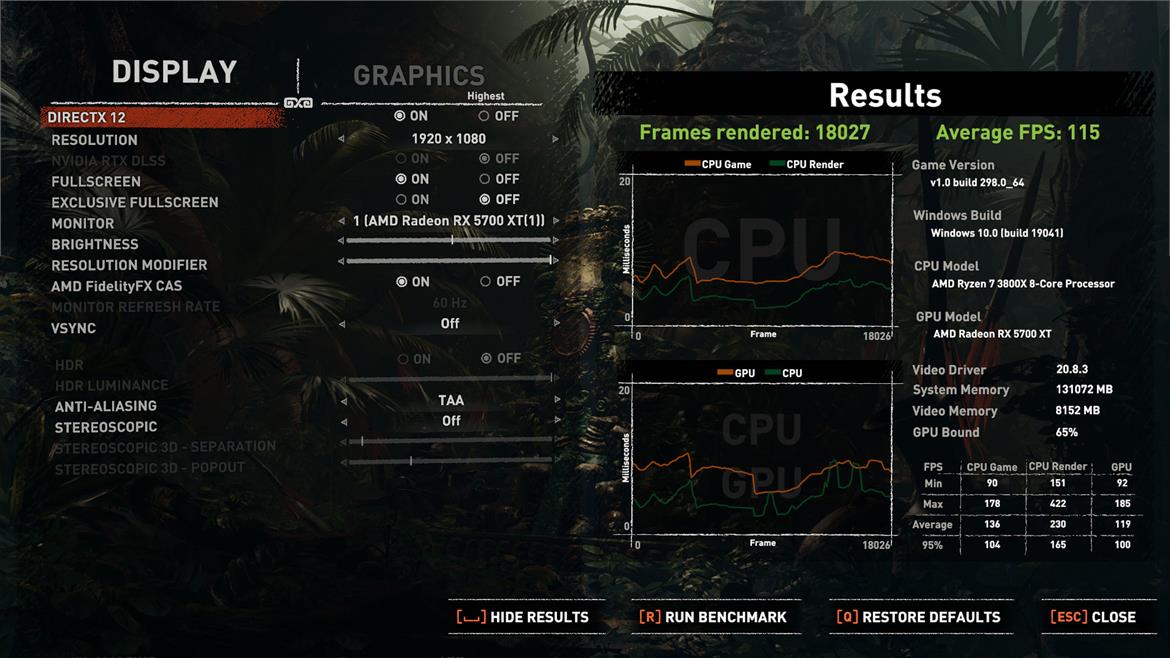
Obviously, it turned out not the fastest system, but in terms of performance it is a strong average, and it copes with its tasks, while possessing a retro charm. And naturally, none of the original eMachines could dream of 115fps in Shadow Of The Tomb Raider at 1080p.
More about performance and speed tests from another era
The original hardware in this case was slow when this computer first came out. I found an old PC Mag review from May 2002 evaluating its successor, the eMachines T1115. The only difference was that there was a 1 GHz Celeron, 100 MHz faster than the 900 MHz Celeron in my T1090. Based on the review, the T1115 scored 24.1 in the Ziff-Davis Business Winstone 2001 speed test.
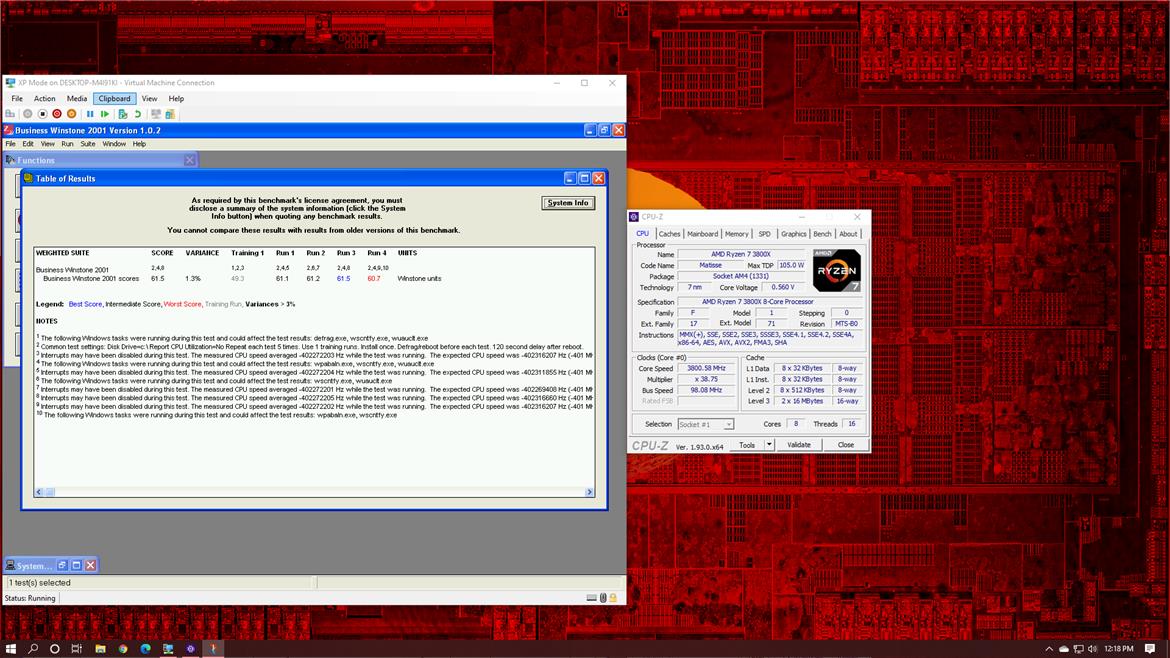
Curiosity got the better of me, and I installed Windows Hypervisor and Windows XP in a virtual machine. To make the situation comparable to that era, before running the test, I limited the virtual machine to one core and 512 MB of memory (the maximum supported by the i810E chipset). It produced 61.5 - about the same as Pentium 4 (Northwood)at 2.2 GHz, judging by Dave's article from that era. I tried running the benchmark in Oracle VirtualBox to see if the results were VM-specific and got a slightly lower result of 54.8.
Despite the fact that the result in VirtualBox turned out to be worse than in Hypervisor, I installed it for a reason, since it supports 3D acceleration (in version 6.0 and later). Armed with acceleration, we went to test the speed in 3DMark 2001SE and Quake 3 Arena (v1.32, Demo Four).
As for 3DMark 2001SE, I found a reviewfrom Dave on Matrox Parhelia 128 MB AGP from 2002, where the results were indicated that can be used for comparison. Then he tested a system with a Pentium 4 2.4 GHz with Matrox Parhelia 512, GeForce 4 Ti 4600 and Radeon 8500. The cards showed 8112, 11 944 and 10 315 results, respectively.
3DMark 2001SE identified the virtual GPU as a Radeon 9500 and delivered 21,334 points - quite a lot of power to play older games without messing with old hardware.
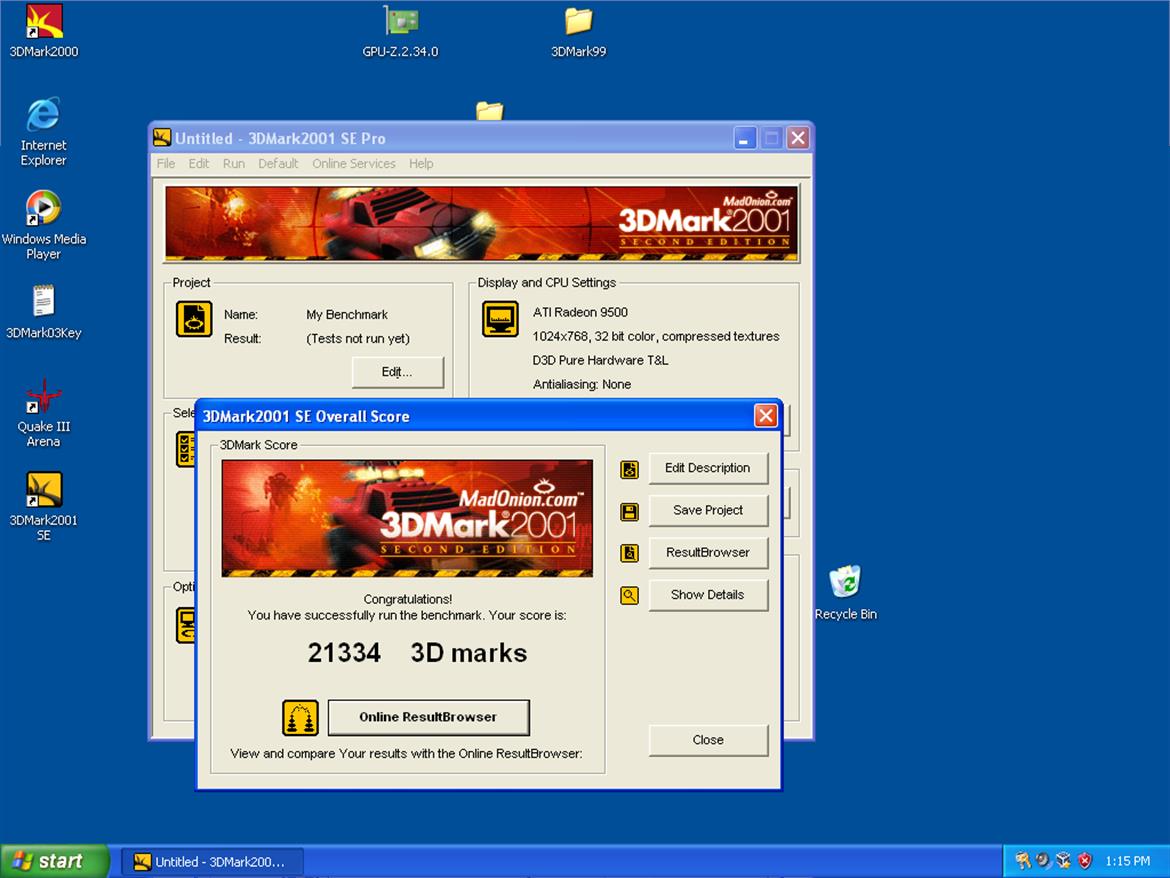
Quake 3 Arena's results were too great to even try to compare them with those of Matrox Parhelia, and therefore we had to switch to the ATI Radeon 9800 Pro 256MB review from Marco from 2003. VirtualBox does not support 1600x1200, so we had to limit ourselves to 1024x768.
In Marko's reviewcompared to Radeon 9800 Pro 256MB, Radeon 9800 Pro 128MB, Radeon 9700 Pro and GeForce FX 5800 Ultra, which showed 227.3, 224.3, 224.4 and 235.3 fps, respectively, without anti-aliasing. The pumped up eMachines showed an incredible 253.9 fps, which puts it on a par with the leading computers of 2003.
Final thoughts on the eMachines retro fashion project
The project began as a sleeper assembly, and ended with a resto-mod [restomod - restoration of old cars with the addition of modern technologies and equipment / approx. transl.]. I didn't manage to shove a mini-ITX motherboard there, which would simplify the procedure, it was much more interesting to tinker with the project because of the difficulties with using the micro ATX form factor, selecting a separate sound card and finding green cards. A bloody sacrifice was also made during the assembly - the old cases were full of sharp edges, which could easily cut yourself.
The system overheats slightly with the Noctua NH-L9a-AM4 heatsinkhowever, at the time of ordering, I thought that I would have very little free space. In the end, I will change it to something with better cooling capabilities, but this is some other time. The redesigned and refurbished computer from eMachines works stably, I haven't had any problems with it yet.

It was very interesting to look for components, process the case with a dremel, chat on various topics with friends from the tech industry, draw stickers and work with my wife on this project. I'm ready to repeat it if I stumble upon a purple Sony Vaio or Compaq Presario 5600 from the late 90s in good condition. The system will live on my desk, next to the main computer (Ryzen ThreadRipper 1950X / Radeon VII / LG 48 "CX OLED), and my wife and I will be able to play Stardew Valley multiplayer sitting next to, and not at different ends of the house - and, of course , in Fall Guys.
Now, if Acer revived the eMachines brand, as it did with Gateway ...